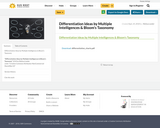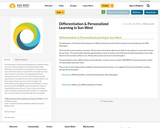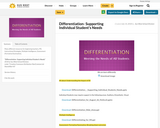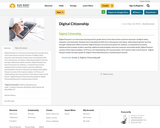
Differentiation Ideas by Multiple Intelligences & Bloom's Taxonomy
- Subject:
- Education
- Material Type:
- Primary Source
- Date Added:
- 09/25/2018

Differentiation Ideas by Multiple Intelligences & Bloom's Taxonomy

The following is a Professional Development on Differentiated Instruction & Personalized Learning following the PeBL Philosophy.
The PowerPoint presentation is narrated. Please look in the bottom right of each slide for the speaker icon and click it to hear the narration. The presentation will take approximately an hour to an hour and a half to go through depending on if you take time to do the activities within or not. Please allow at least one hour to work through it.
The presentation covers: differentiation, personalization, content, process, product, REORDER, pyramid of growth, transfer of responsibility, and much more!
There is also a note-taking outline available to download and print below. It is suggested that you do this before working through the presentation.

Many different resources for beginning teachers, PD, Instructional Strategies, Multiple Intelligence, Assessment (Formative/Summative),

The first video segment presents a canonical mathematical example from quantitative biology, in which mRNA is transcribed from a gene sequence, and protein is translated from mRNA. The second segment uses eigenvector-eigenvalue analysis to sketch the trajectories of the system in a phase portrait. Finally, the third segment generalizes the linear stability analysis used to study this example.

This resource breaks down when it is necessary to get a line locate prior to completing groundwork.

In a multi-week experiment, student teams gather biogas data from the mini-anaerobic digesters that they build to break down different types of food waste with microbes. Using plastic soda bottles for the mini-anaerobic digesters and gas measurement devices, they compare methane gas production from decomposing hot dogs, diced vs. whole. They monitor and measure the gas production, then graph and analyze the collected data. Students learn how anaerobic digestion can be used to biorecycle waste (food, poop or yard waste) into valuable resources (nutrients, biogas, energy).

To reinforce students' understanding of the human digestion process, the functions of several stomach and small intestine fluids are analyzed, and the concept of simulation is introduced through a short, introductory demonstration of how these fluids work. Students learn what simulation means and how it relates to the engineering process, particularly in biomedical engineering. The teacher demo requires vinegar, baking soda, water and aspirin.

The digestive system is amazing: it takes the foods we eat and breaks them into smaller components that our body can use for energy, cell repair and growth. This lesson introduces students to the main parts of the digestive system and how they interact. In addition, students learn about some of the challenges astronauts face when trying to eat in outer space.

Hank takes us through the bowels of the human digestive system and explains why it's all about surface area.

In this video we introduce the digestive system. We look at the two types of digestion: mechanical digestion and chemical digestion. We also look at the two subdivisions of the digestive system: the digestive tracts and the accessory structures.
Lesson 1 in our Digestive System series. This is part of our Anatomy and Physiology lecture series.
If this video helps you please be sure to LST -like subscribe and tell your friends. Your support helps us make more videos. For the complete series please visit http://mrfordsclass.net/
Other Free Videos in the Digestive System series:
-Introduction to the Digestive System (18:01): http://youtu.be/V71Ao98KePI
-The Mouth (18:02): http://youtu.be/-LWqhNaQjvk
-The Throat (18:03): http://youtu.be/guXIwvrUGM4

The mouth is our first stop in our digestive system. It is made of our cheeks, lips, tongue, and teeth. We take a look at the mouth as well as the components and how they help with the digestion of food.
Lesson 2 in our Digestive System series. This is part of our Anatomy and Physiology lecture series.
If this video helps you please be sure to LST -like subscribe and tell your friends. Your support helps us make more videos. For the complete series please visit http://mrfordsclass.net/
Other Free Videos in the Digestive System series:
-Introduction to the Digestive System (18:01): http://youtu.be/V71Ao98KePI
-The Mouth (18:02): http://youtu.be/-LWqhNaQjvk
-The Throat (18:03): http://youtu.be/guXIwvrUGM4

Moving down the digestive system we take a look at the throat. Specifically we examine the pharynx, and the esophagus. We also look at how we swallow, breaking it down into the two phases.
Lesson 3 in our Digestive System series. This is part of our Anatomy and Physiology lecture series.
If this video helps you please be sure to LST -like subscribe and tell your friends. Your support helps us make more videos. For the complete series please visit http://mrfordsclass.net/
Other Free Videos in the Digestive System series:
-Introduction to the Digestive System (18:01): http://youtu.be/V71Ao98KePI
-The Mouth (18:02): http://youtu.be/-LWqhNaQjvk
-The Throat (18:03): http://youtu.be/guXIwvrUGM4

A read-aloud of Patricia PolaccoŐs "Thank You, Mr. Falker" helps promote deeper comprehension through questioning to achieve personal connections and discussions of character and theme.

This lesson, in which students research worms in order to create a classroom habitat, incorporates reading and writing across content areas as well as math and science activities.

You can browse a database of public-domain titles from various websites, and access a collection of over 100,000 free audiobooks and e-books.
Additionally, the free membership lets you create a personal bookshelf for future reading, so you won’t have to hunt for books you’ve previously considered. On Digital Book, you’ll discover classics, new releases, and everything in between—perfect for family audiobooks on your next road trip.
Search by popularity, genre, language. Use the menu at the top to go directly to audiobooks or ebooks.
Note - more books than audio books.

Digital cameras are part of the aresenal of tools web designers need to use to produce oriignal images on web sites. Although many types of cameras are available, there are common elements in their use that are important for developing a sound foundation in the design of a web site.

Digital Passport is an interactive learning tool for grades three to five that teaches
and tests the basics of digital safety, etiquette, and citizenship. Students learn
foundational skills from online games and videos, while deepening their learning
through collaborative offline activities. Digital Passport has interactive games for
students, a comprehensive teacher dashboard that includes student reporting,
additional downloadable classroom materials and module guide. Digital Passport
consists of five topical modules: (1) Privacy, (2) Cyberbullying, (3) Communication,
(4) Creative Credit, and (5) Search.
*Digital Passport follow the policy guide for Digital Citizenship Education in
Saskatchewan Schools

Help students reflect on how their digital lives impact their social and emotional well-being in three simple steps.
1. Engage students in daily activities
2. Build your digital citizenship roadmap
3. Promote digital citizenship in your community

"Being a parent has never been easy, but it can be even more challenging once your kids are using the internet. Even if you're not up on the latest technologies and platforms, though, you have an important role — maybe the most important — in your kids' online lives. This guide will prepare you for the conversations you need to have with kids when they first start using digital devices, as they grow and their online activities change, and when things go wrong.
The guide is divided into three sections that each deal with a different aspect of digital citizenship, to teach your kids to Respect People's Feelings, to Respect Privacy and to Respect Property online."

Ready-to-teach lessons to address your changing needs in the classroom.
"Help students take ownership of their digital lives.
Common Sense digital citizenship topics include media balance, cyber-bullying, news and media literacy, online privacy, digital footprint, and communication.
All students need digital citizenship skills to participate fully in their communities and make smart choices online and in life. Our award-winning K–12 Digital Citizenship Curriculum:
Addresses top concerns for schools.
Prepares students with critical 21st-century skills.
Supports educators with training and recognition.
Engages the whole community through family outreach."
Lessons are available in grade groupings for K-2, 3-5, 6-8 and 9-12.